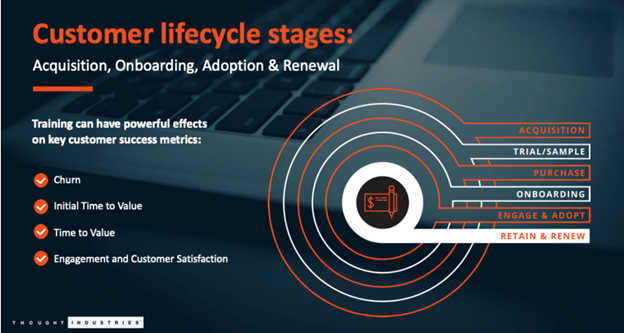Recent benchmark data from a Technology Services Industry Association (TSIA) study, The Pandemic Work Model for Renewing Recurring Revenue, reveals that approximately 17% of revenue for hardware companies is derived from recurring revenue. This accelerates to 38% for software companies. For SaaS companies, the percentage is in the mid-90’s.
Product training drives adoption, which will improve customer retention.
The report explains the reason why a customer retention model is so critically important:
“If you have a goal to grow 15%, but you lose 10% of your customer dollars to downsell and churn, you have to actually sell 25% more to grow that 15%. It’s still better than a transactional model, where every quarter you start at zero, but if you want the growth promised by the subscription model, you have to effectively renew the customers you already have.”
Customer retention strategies, therefore, are key to business growth and resiliency, especially in these uncertain times. Here are 10 proven online strategies on how to increase customer retention and reduce churn during an economic downturn.
Training Strategy 1: Training throughout the Entire Customer Lifecycle
One of the most fundamental methods of retaining customers is by training them. Indeed, there is always a need to train existing customers because change is a constant, especially in the world of SaaS.
Your product changes, their personnel changes, job descriptions and team focus change, to name just a few. The one thing that never changes is your customer’s need to achieve value with your product. Training, at every stage of the customer lifecycle, helps your customers use your product better and faster.

You can find an in-depth discussion of customer training throughout the customer journey between Thought Industries’ Barry Kelly, and TSIA’s John Ragsdale, in the blog Aligning Customer Training to Customer Success Strategy.
Training Strategy 2: Accelerate Time-to-value
Time-to-value is an important measure of customer success, during the onboarding process and throughout the customer lifecycle. It is a leading indicator of churn and a strong starting point for determining how to increase customer retention.
The longer it takes for a customer to realize this value (as they define value), the less likely you are to retain the customer.
There are two types of time-to-value:
- The first is initial time-to-value. This is the number of hours, days or weeks it takes for customers to find value using your product. The clock starts ticking when the contract is signed. Ideally, this should happen soon after activation.
- The second is time-to-ROI. This is defined as the time it takes for the customer to realize measurable improvement to their use case, in a form that can be presented to the VP of Finance or CFO.
You will find a stimulating discussion in the blog post, How to Reduce Time-to-Value with Modern Customer Training.
Training Strategy 3: Start with Pre-sales Training
Another way to improve customer retention is through pre-sale training. Stated simply, the more customers know about your product before the sale, the more likely they are to buy, and the faster they’ll get value after the sale.
Starting customer training earlier, within the actual consideration journey, allows you to build trust, recognition of how you can bring value, and establishes your brand as an authority.
We’ve found that these early learning experiences offer deeper engagement than most marketing programs and nurture educated buyers who tend to be far more engaged, agreeable, and referenceable than non-educated buyers.
Find more information on how to increase customer retention through pre-sale training here: Building a Customer Training Program That Starts to Work Even Before the Sale.
Training Strategy 4: Product Adoption through Customer Onboarding
Customer account retention strategies wouldn’t be complete without discussing the significance of onboarding.
The basic job of customer onboarding is to make sure the customer is trained on how to use your product. But the onboarding experience is also about embracing the concept of time-to-value. When a user can come to his or her boss and say with excitement, “Look at this!”, then the customer onboarding phase is nearing completion.
“There’s a lot of data out there around adoption timeframes,” notes Thought Industries CEO Barry Kelly. “If customers don’t really adopt the product and see traction with it quickly, during the honeymoon stage, the chances of gaining traction later are less likely.” Your customer is more likely to use your product or service if they have actually seen it add value to their lives—and quickly.
This article shares seven techniques for making sure you squeeze every ounce of benefit from your onboarding efforts: 7 Steps to the Perfect Customer Onboarding Program.
Training Strategy 5: Innovate Your Blended Learning
Another key strategy to improve customer retention is through blended learning. This approach combines the best of all customer training programs to reach more learners more effectively and at a lower cost. Online training and opportunities for interaction are interwoven with virtual and traditional instructor-led training.
Introducing blended learning to your customer retention model allows you to be more responsive to the needs of cohorts who grew up digitally and whose learner experience must include access to information on-demand, on any device.
An informative case study on this topic comes from ArrowStream, a leading provider for food service supply chain management. Their innovative approach to blended learning leverages online resources as a gateway to live training. The result – time spent training decreased by 74% while retention remained constant – zero churn.
You will find more information in this case study, ArrowStream Migrates to Blended, Online Customer Training – Reduces Training Hours 74%.
Training Strategy 6: e-Learning to Reach New Learners
Your customers are constantly in flux. Personnel change all the time: some are promoted, some are reassigned, some leave, new ones are brought in. The one thing that doesn’t change is the need for every user to understand how to use your product so that they quickly find value.
For individuals and team members who are new on the scene, having arrived after onboarding, eLearning and video are perfect for them.
Integrating eLearning into your customer retention model is a comprehensive, on-demand, and effective way to bring new users and team members up to speed when it’s the right time for them. Cost is also negligible as the content has already been created.
Furthermore, there is zero distribution cost. New learners do not have to wait for an expensive instructor-led (ILT) class to be scheduled.
Training Strategy 7: Address Skills Gaps Appropriately
Certainly, it’s critical to train on the basics of your product – hit this key when you want to do this. But more advanced training is needed to respond to the job requirements of individual learners, as well as their strengths and weaknesses. If follow-on training is one-size-fits-all, you are missing a host of opportunities.
One of the methods of retaining customers is to individualize learning paths. Customers are more likely to keep using a product if their learning is customized and tailored to the task they want to accomplish and their needs. These individualized learning paths respond to what an individual needs to know, and just as important, does not need to know to do their job well.
Specific skill gaps can be addressed. And for super-users, a special set of advanced training so that they, in effect, become part of your Customer Success team. They become the first line of response if there is a question or an issue, which in turn leads to greater value for your customer, faster.
Training Strategy 8: Improve Learner Engagement
Another answer to how to increase customer retention is keeping learning relevant and fresh, and having a meaningful way to measure business impact. Major challenges to delivering high-impact customer training start with learner engagement, content management and authoring.
In our third annual 2021 State of Customer Training Report released last month, 36% of respondents indicated “focusing more on learner engagement” has become more important in light of the global pandemic.
Improving learner engagement is a proven strategy for differentiating your training in a crowded and competitive marketplace. Learner engagement is one of the most powerful ways to:
- Ensure that learners complete the course, internalize and incorporate the training.
- Increase learner satisfaction and accomplishment.
- Create satisfied learners that are active, loyal and willing to share with their peers.
Learner engagement, which includes tactics such as learning paths, gamification, certification, video, in-app widgets, social learning, and more, have a profound impact on the effectiveness of your training, course enrollments, and your near and long-term revenue.
Plus, learner engagement takes on greater urgency when online, where learners can often feel isolated and disconnected. Improve your learner engagement, and you’re guaranteed to improve customer retention and learner satisfaction, as well.
Check out this blog for more tools and tips: 5 Tools to Improve Online Learner Engagement.
Training Strategy 9: Turn Customers into Advocates
Training is arguably the most important part of every customer success program, but customers don’t have the time to master your product like you want them to. Sometimes they put off training until it’s too late, which results in expensive support and unhappy customers.
The solution is to treat your customer training programs like your company’s products and insert a healthy dose of marketing into driving training consumption.
Three valuable methods of retaining customers and turning them into advocates include:
- Promoting learning paths – what’s the next course and the one after that.
- Identifying the learners who are most likely to continue with training, and invest in them.
- Bundle training into logical packages.
Here, check out these 22 Ways to Promote Your Training & Turn Customers into Advocates.
Training Strategy 10: Improve Customer Success
Last one on our list of customer account retention strategies is the improvement of customer success.
A competitive advantage that’s based on features and functions is not sustainable. If another company has the will and the money, their developers will eventually find a way to duplicate and one-up you. Then it devolves into an arm’s race. The answer, especially for SaaS companies is customer success.
Customers must get the value they paid for or they are not going to renew, and renewal is based on the subscription model. Consider that the customer acquisition cost takes 18-24 months to recoup. If a new customer doesn’t renew, it’s a dead loss.
Customer success is dedicated to increasing the value your loyal customers receive from your company, and turning that into profit.
You can find a thorough discussion of customer success in our interview with Mikael Blaisdell, an acknowledged expert in customer success, here: How Customer Success Drives Profitability of SaaS Companies.
We hope these online training strategies have helped shed light on how to increase customer retention, and that by implementing these, you come out stronger on the other side.




